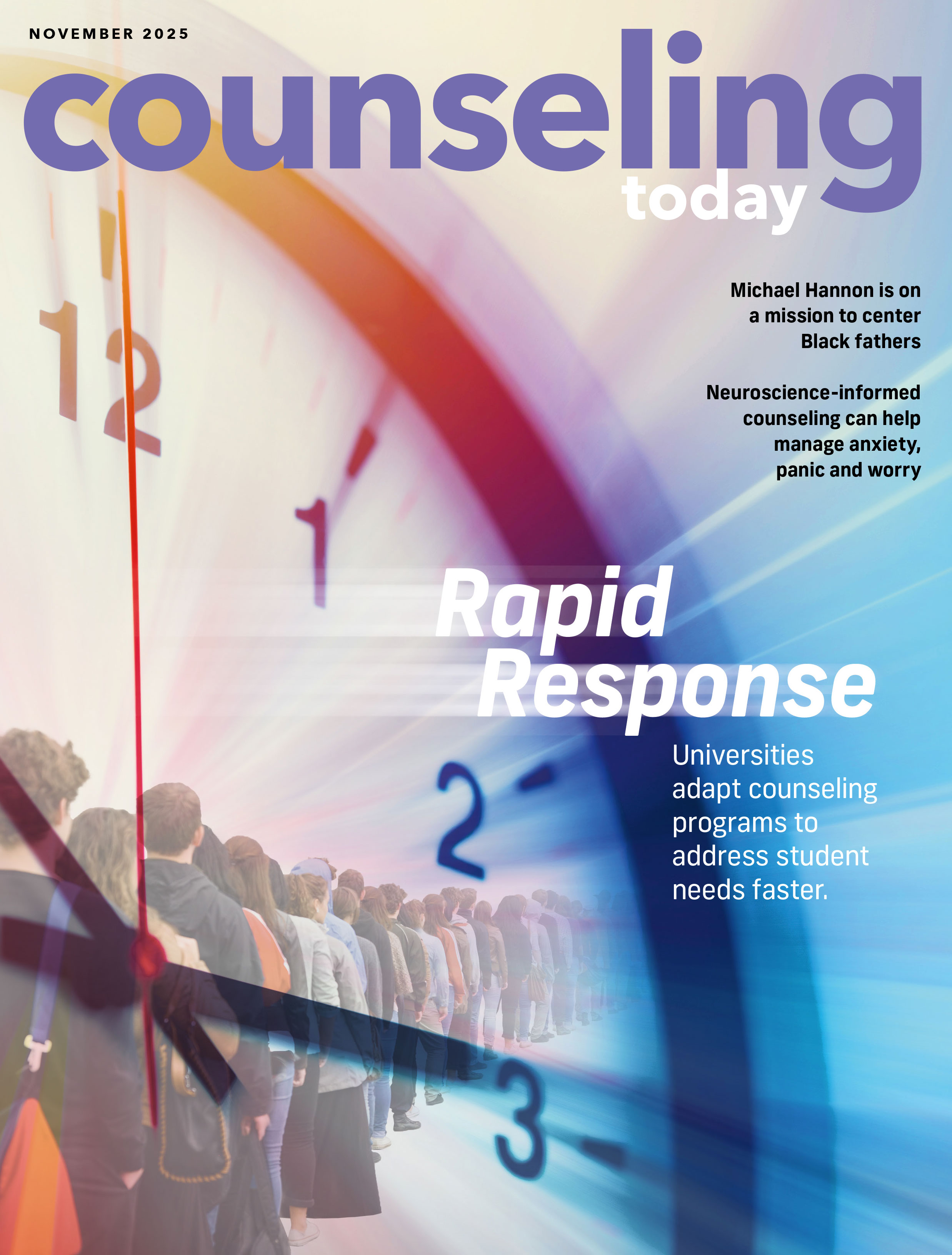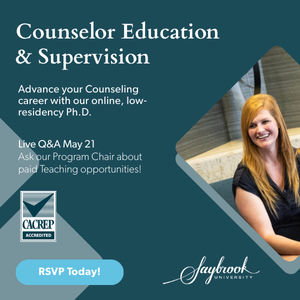Explore Counseling Today Articles
The intersection of childhood trauma and addiction
Substance dependence leads to persistent negative consequences and the loss of human potential. These consequences often include chronic health problems, dysfunctional family environments, harmful economic impacts and premature death. According to the Centers for Disease Control and Prevention (CDC), 21.2 million individuals in the United States met the criteria for a substance-related disorder in 2018. Deaths from overdose have tripled in less than two decades, with over 70,000 annual drug overdose deaths in 2019, 70% of which resulted from opioids such as morphine and fentanyl.
Substance-related disorders include 10 classes of drugs: alcohol; caffeine; cannabis; hallucinogens; inhalants; opioids; hypnotics, sedatives and anxiolytics; stimulants; tobacco; and other/unknown substances. Exposure to childhood trauma increases one’s risk of addiction across classifications, along with deleterious factors such as physical health and socioeconomic challenges. The Adverse Childhood Experiences (ACE) study, originally conducted by Kaiser Permanente and the CDC from 1995-1997, identified categories of trauma that can occur prior to age 18. These include physical abuse and neglect, emotional abuse and neglect, sexual abuse, and household dysfunction — e.g., mother treated violently, household substance misuse, parental incarceration, parental mental illness, and divorce.
These factors make up the 10 components of the ACEs score, with research supporting higher likelihood of substance-related disorders as exposure to ACEs increases. According to the American Society of Addiction Medicine (ASAM), addiction has biological, psychological, social and spiritual manifestations. Given the deleterious nature of addictive etiology, professional counselors need to be aware of the vulnerability to addiction for those affected by childhood trauma. The intersection of ACEs and addiction holds pervasive negative impact across the life span.
The National Institutes of Health (NIH) asserts that traumatic events can serve as triggers for substance misuse. NIH reported that 38% of high school seniors admitted using an illicit substance in 2019, with marijuana being the most frequent substance utilized. Startlingly, 11.8% of eighth graders reported marijuana use. In addition, 11.7% of high school seniors reported daily nicotine use, and more than half acknowledged using alcohol in the prior year.
Exposure to ACEs can lead to toxic stress and myriad negative consequences, often including lifelong deleterious effects on physical and mental health. The high rates of individuals living with the trauma of ACEs is startling — 61% of individuals have endured at least one ACE, and nearly 25% of individuals report three or more ACEs. There appears to be specific vulnerability to addiction for those who have experienced four or more ACEs. The higher the ACEs score, the greater the negative health impact. More than half of adolescents who live with mental health concerns also have diagnosable substance-related disorders, which underscores the comorbidity of the issue.
Ramifications of ACEs can include addiction, reduced access to education, and vulnerability to sexual exploitation and trafficking. Tobacco and prescription drug use is higher among those with ACEs, and illicit drug use increases more than twofold with each positive ACEs category. Other lifelong instability factors that have been shown to correlate with ACEs are high-risk sexual behaviors, early pregnancy, suicide attempts, sleep disturbance, poor dental health and multiple physical health concerns. Both children and adults with extant mental health issues misuse substances at higher rates.
According to the U.S. Surgeon General, approximately 10% of children live with mental health concerns that rise to a clinical level, with major depressive disorder representing a leading cause of disability in children worldwide. Research supports the strong connection between experiencing adversity during childhood and the ensuing development of addiction. More than two-thirds of children will experience a traumatic event before the age of 16. And with the current pandemic, many children are in homes that are violent or otherwise unsafe. Alarmingly, domestic violence incidents were up 30% in 2020, exposing untold youth to at least one of the ACEs factors.
Treatment needs
Reports regarding heightened clinical levels of anxiety and depression among the general population suggest that stress related to the COVID-19 pandemic affects everyone. Adolescence already represents a critical developmental period for initial onset of mental health and substance-related disorders, so the vulnerability for this demographic is further increased. ACEs are a clear and extant risk factor, with survivors of childhood trauma 15 times more likely to attempt suicide, four times more likely to develop an alcohol-related disorder, and 2.5 times more likely to smoke cigarettes. For survivors of childhood trauma, physical and emotional issues often manifest in adolescence and follow into adulthood.
According to the Substance Abuse and Mental Health Services Administration (SAMHSA), 21.6 million people ages 12 and older needed treatment for substance use in the U.S. in 2019, whereas only approximately 2.6 million people (or slightly more than 12%) received it. These are glaring treatment needs that crosscut demographics. Fentanyl, which can be lethal, is sold in multiple forms on the “street,” continuing the opioid crisis in our country. Tens of thousands of overdose deaths occur per year, with close to 11 million individuals disclosing inappropriate opioid use. Those with ACEs scores higher than 6 were over 1,000 times more likely to use injection drugs.
Chronic substance abuse, a clear risk factor for those exposed to trauma, leads to premature death in alarmingly high numbers. Adolescents with experience of major depressive episodes are more likely to use substances across categories. Coincidingly, 60% of U.S. youth with depression do not receive mental health treatment. Addressing the physical and mental health impact of substance use alone is estimated to cost Americans more than half a trillion dollars annually. The CDC has developed a resource that highlights the available research support for evidence-based prevention of ACEs at cdc.gov/violenceprevention/pdf/preventingACES.pdf. These strategies focus on systemic community-based information and training. Emphasis is also placed on physical health, positive behaviors and supportive environments.
Treatment considerations
Certain populations have increased vulnerability to substance-related disorders due to environmental and genetic factors. This stems from the neurobiological underpinnings of the addictive etiology to the effects of toxic stress. Individuals born into households in which they are exposed to ACEs are more vulnerable to addiction, including process addictions centered on gambling, internet gaming, sex, shopping, work, social media and so on. The use of trauma-informed interventions as early as possible can mitigate deleterious effects and provide protective measures against substance-related and other mental and physical health issues. The CDC offers trainings for those interested in learning more about the prevention of ACES (see vetoviolence.cdc.gov/apps/aces-training/#/#top).
All clients should be evaluated for trauma and addiction history. The concurrence of mental health concerns and substance abuse necessitates treatment that addresses these challenges. Trauma increases the already high comorbidity (upward of 50%) between mental health and substance use diagnoses. Prevention and early intervention services can examine frequency, severity and duration of both the trauma experience and the addiction. The conceptualization of substance use disorders occurring on a continuum (as detailed in the fifth edition of the Diagnostic and Statistical Manual of Mental Disorders) underscores the importance of prevention and early intervention.
According to the CDC, research shows a propensity to self-medicate with substances to escape or numb negative thoughts and feelings. This suggests that escape from emotional pain triggers the onset of addiction. Women, adolescents and individuals from marginalized populations are most vulnerable to these effects, although anyone can experience childhood trauma and struggle with ensuing addiction.
Clinicians should develop individualized treatment plans and strong referral systems. Genetic and environmental factors work in combination. Thus, we need to gain understanding of these interactive effects. Long-term supports and provision of physical and dental health services can be important for individuals exposed to ACES, especially considering the likelihood of comorbidity with a physical health diagnosis. Increased rates of unemployment and job dissatisfaction represent additional treatment needs.
Relational challenges
Difficulty forming healthy relationships across the life span is a hallmark of surviving childhood adversity. Counseling professionals should thus incorporate strategies for strengthening the family and community. Holistic and family counseling services are beneficial. This includes the provision of psychoeducation and parenting education to address overall life skills, mindfulness and grounding techniques, positive coping strategies and career counseling services. Trauma-focused cognitive behavior therapy (TF-CBT) and multisystemic therapy have shown both short- and long-term benefit with these clients. This can be combined with addiction treatments such as medication-assisted therapy for alcohol or opioid use disorders. The combination of psychoeducation and supportive, trauma-informed and empirically based substance misuse treatments can span the broad needs of this population. All treatment modalities and providers should integrate trauma-informed care.
Early identification and intervention remain important to minimize risks and break deleterious family patterns. Removal of barriers to treatment includes addressing stigma and increasing education for families and communities. Larger scale prevention programs, inclusive of early intervention and postvention services, are indicated. The development of individualized treatment strategies that incorporate trauma-informed interventions are also vital.
Professional counselors are charged to advocate for clients and communities. Screenings in hospitals, clinics and public health facilities can help identify those at risk for substance misuse, especially those with trauma histories, and link them with treatment services. Psychoeducation in schools and community agencies also can improve outreach and access to care. Parenting education classes and life skills trainings are other examples of additive ancillary services. Incarcerated populations are particularly affected, with some studies suggesting a trauma history for nearly the entire population of female inmates. Professional counselors working across these settings should be aware of risk factors and assessment protocols that are culturally competent and inclusive of multiple demographics.
Effective treatments for individuals affected by trauma and addiction can include eye movement desensitization and reprocessing, motivational enhancement therapy, TF-CBT, dialectical behavior therapy, assertive community treatment and family behavior therapy. Psychotropic medication and psychiatric care may be indicated to fully address these complex issues. Some medications may benefit multiple issues (e.g., bupropion for both depression and nicotine dependence). Case management and occupational assistance represent important ancillary services for many clients. Community vouchers can be given for transportation and health care access and allow for possible employment opportunities.
Although thorough and comprehensive treatment can be expensive, it pales in comparison to the economic costs associated with addiction and premature death. With annual estimates for addiction and premature death as high as $740 billion, there is a need for legislation that funds prevention and early intervention services for those affected by trauma exposure and addiction. Given appropriate access to treatment and support, many individuals living with the effects of childhood trauma and addiction can make positive and lasting improvements. The cycle of intergenerational trauma transmission can be broken, providing positive ripple effects for future generations. Individuals can thrive and build healthy families despite their adverse experiences.
Community impact and integrated care
A multitiered approach to looking at immediate issues such as addiction is imperative for individuals exposed to ACEs. Addressing the trauma and providing familial services, social support and preventive measures remains imperative. All professional counselors can emphasize trauma-informed and integrative care. Here are a few simple strategies to tackle this complex issue: Listen with empathy, garner training in trauma-informed practices, develop a strong support and referral system, and provide specialty services to treat the trauma and the addiction. Working together, mental health professionals across disciplines can help survivors of childhood trauma manage life in healthy and productive ways.
The global health pandemic has increased utilization of distance-based services such as telemental health counseling. This modality can provide easier access to services for individuals in rural communities, those with transportation challenges and those with other impediments to treatment.
It remains important to highlight the team approach in addressing the complex issues of childhood trauma, addiction, and the ensuing physical and mental health sequelae. The pervasive nature of this challenge engenders a call to action. Data collection through thorough assessment can inform community decision-making and provide program funding. The Youth Risk Behavior Surveillance System assesses crosscutting data that are available at the local, state and national levels. The National Survey of Children’s Health and the National Crime Victimization Survey also collect data that can inform service provision.
The CDC provides information to promote safe childhood environments and mitigate ACEs exposure and subsequent addiction and disease. On a micro level, professional counselors can focus on parenting and family skills, mentoring, social emotional learning, job skills, and psychoeducation regarding healthy family and interpersonal relationships. On a macro level, professional counselors can promote community connection, mentoring relationships and positive social norms. The critical importance of trauma-informed interventions that are tailored to individual or family circumstances, along with communitywide prevention strategies, are necessary for addressing these serious and prevalent risk factors. These programs can assist children, parents and families beyond mitigation of symptoms.
Family-centered treatments for addiction can address the intergenerational impact. The deficits that come with trauma and addiction are offset by evidence-based interventions and prevention strategies. Access to programs should be available for all levels of care and can be implemented concurrently with ancillary services. Counseling settings can include the home, school or office, and often will involve multiple integrated health care professionals. Given the complexity of the challenge, comprehensive treatment services that include bridging home and school environments and the larger family system remain imperative. The widespread impact of ACEs and their intersection with addiction calls for coordinated care across disciplines. This includes effective tracking and coordination of prevention and intervention services across all aspects of service delivery.
Intergenerational patterns of trauma transmission represent a vicious cycle that professional counselors can help break. Prevention programs must address household dysfunction and adversity, especially considering that ACEs indicate earlier onset of substance consumption. The idea of numbing or comfort-seeking suggests that childhood adversity can lead to addiction through attempts to relieve distress. Quality mental health care can address and ameliorate these maladaptive coping mechanisms. ACEs are also correlated with substance use disorder in older adulthood, underscoring the lifelong ramifications of exposure to childhood trauma.
Addiction treatment facilities partnering with comprehensive and wraparound services can provide targeted interventions to address individual trauma experiences. Tackling the systemic nature of childhood adversity through family services and community advocacy provides additional resources for clients. Professional counselors are an integral part of the overall treatment team. Clients can and do learn new patterns of behavior and positive coping mechanisms that help them live longer, healthier lives. The benefits of prevention and early intervention should not be undervalued. Treatment is ameliorative for trauma and addiction and often engenders positive change in individuals and families.
Professional counselors can assist community members in locating resources and addiction treatment centers across the country via SAMHSA’s national helpline: 800-662-HELP (4357). Viewing survivors of childhood trauma who struggle with addiction or other maladaptive coping mechanisms from a strength-based approach is imperative. These struggles are not born of characterological weakness but result from the impact of lived trauma experiences. Empathy and care go a long way in successful work with trauma survivors.
Conclusion
Abuse, neglect and household dysfunction clearly lead to physical and mental health challenges. The risk of addiction, early death and intergenerational trauma transmission increases with each adverse childhood exposure. Use of alcohol and other illicit substances damages mental and physical health in numerous ways and often intersects with the trauma experience. Vulnerable children and adolescents can and must be protected. Professional counselors play pivotal roles now more than ever.
In 2020, SAMHSA reported a 900% increase in call volume to its disaster distress helpline (800-985-5990). Nearly half of Kaiser Family Foundation respondents asserted that the COVID-19 pandemic is detrimental to their overall mental health. The global health pandemic underscores the burgeoning treatment needs for increasing numbers of vulnerable people. Experiencing trauma in childhood can hinder the individual in all aspects of life. The negative reverberations for families and communities should make this everyone’s issue. Professional counselors hold the potential to help effect positive change for innumerable individuals, families and communities. Let’s make an impact — now and into the future.
****
- Assessment, Diagnosis & Treatment
- Substance-Related & Addictive Disorders
Search CT Articles
Filter CT Articles
Current Issue
Sign Up for Updates
Keep up to date on the latest in counseling practice. Sign up to receive email updates from Counseling Today.



